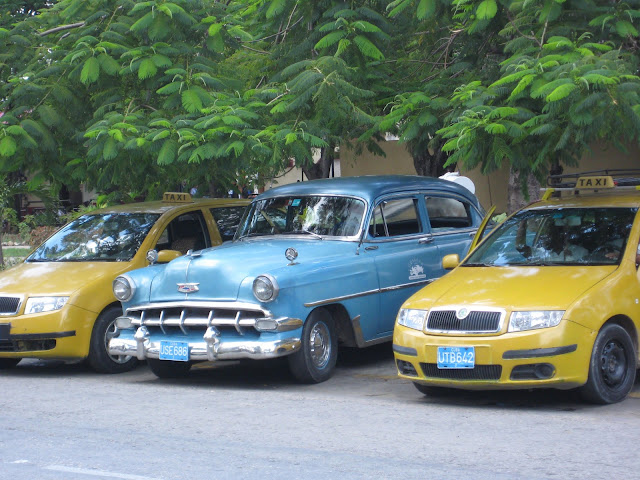Cuba, Pearl of the Antilles
This blog should be read TOP to BOTTOM, keeping in mind the necessity of selecting "OLDER POSTS" at the bottom of a page to reach the earlier material. Any errors are the author's, of course.
This aerial view from Google reminds us of the very large size of Cuba, the largest Pearl of the Antilles, a land mass always coveted by the United States. This trip began with a flight from Miami to Santiago de Cuba, located southwest of Guantanamo, in the eastern tip of the island.
|
 Arriving at Santiago de Cuba airport, eastern end of Cuba, April 13, 2012, after a flight from Miami.
Arriving at Santiago de Cuba airport, eastern end of Cuba, April 13, 2012, after a flight from Miami.
Customs officials directed this dog to sniff suitcases and large wrapped parcels arriving on our flight.
|
Tour Guide and Bus Driver
|
Cuban friends and relations of arriving passengers have to wait outside the airport.
|
Authority to travel to Cuba granted by the U.S. Dept. of Commerce and the U.S. Treasury Dept., Office of Foreign Assets Control, for the purpose of delivering Humanitarian Aid and Goods. |
 |
| Father Valentin Zubizarreta y Unamunsaga [?] Archbishop of Santiago de Cuba. In remembrance and gratitude for his great apostolic work for the Catholic people of Cuba. |
 |
| Flight to Egypt |
 |
| Sor Nora and her assistant arrive to pick up many bags of humanitarian donations, such as hygienic supplies and medicines. |
 |
| This unusual chariot was parked outside the hotel, waiting for tourists to take the opportunity of riding in it. What model car is this, and what year? |
 |
| Once back in the U.S., a neighbor researched and discovered this photo of a shiny 1934 Packard parked in a showroom. |
 |
| This converted truck provides bus transportation for many of the Cuban people. |
 |
| Taxi |
 |
| Taxi |
 |
| Ordinary transportation versus Tourist transportation. |
 |
| There were plenty of non-U.S. autos in Cuba, but very few were photographed. |
 |
| See the name of the gas? Oro Negro. Black Gold. |
 |
| Taxis. |
 |
| Sr. Aguilera |
 |
| In the back room at the studio. |
 |
| This series is by another artist at Taller Aguilera, possibly Aguilera's son? His "signature" motif is the white polar bear. |
 |
| ART |
 |
| LIFE |
 |
| Art Card: Padre Pico No. 1, Cromoxilografia, 1965.
[Source: lifted from Wikipedia, with some editing.] In the chromoxylography process, the printer engraved the image on the woodblock, carving away areas not to be printed (or inked). A separate wood block was used for each of the three primary colours, with the ink coating the uncut areas. The printer engraved the image to the finer end grain of the woodblock. For more complicated work the carver worked on the end grain of the wood, and, with the use of fine hatchings to the wood that were inked separately, achieved the look of blended colours.
Variations in tone were achieved with skillful carving to create the appearance of stipple. To create a blend of colours, blocks were hatched horizontally and diagonally to allow applications of multiple colours that resulted in browns, greens and greys. "A blockmaker would know whether to engrave thin white lines (for an almost solid tone), medium white lines (a mid-tone) or crosshatchings (leaving larger or smaller lozenges of colour to achieve sometimes little more than a faint tint when seen at a normal viewing distance)." Overlapping diagonal lines were carved to create dot-like shapes on the surface that took less ink and resulted in paler tones.
|
 |
| Four street scenes hanging on the wall at the Botalin studio. |
 |
| Exterior of the Botalin residence/studio in Santiago de Cuba. The Botalins live upstairs behind the ironwork facade. |